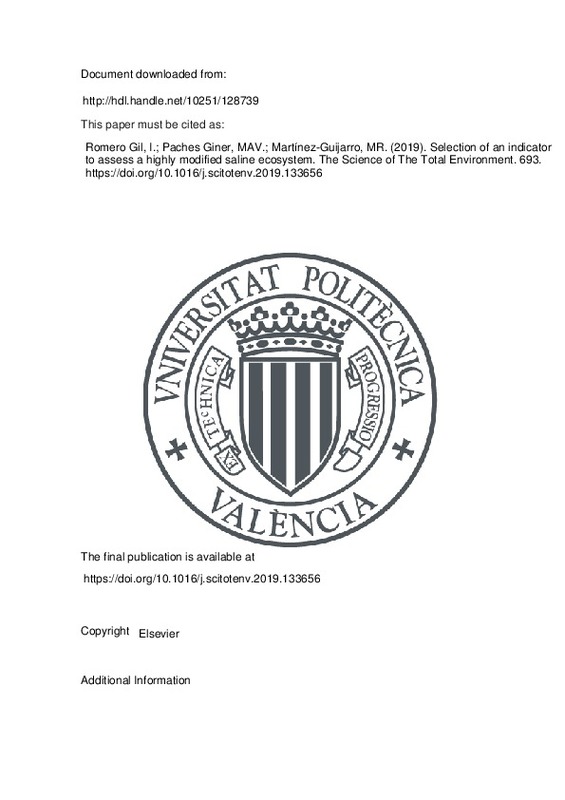JavaScript is disabled for your browser. Some features of this site may not work without it.
Buscar en RiuNet
Listar
Mi cuenta
Estadísticas
Ayuda RiuNet
Admin. UPV
Selection of an indicator to assess a highly modified saline ecosystem
Mostrar el registro sencillo del ítem
Ficheros en el ítem
| dc.contributor.author | Romero Gil, Inmaculada
|
es_ES |
| dc.contributor.author | Paches Giner, Maria Aguas Vivas
|
es_ES |
| dc.contributor.author | Martínez-Guijarro, Mª Remedios
|
es_ES |
| dc.date.accessioned | 2019-10-16T20:00:58Z | |
| dc.date.available | 2019-10-16T20:00:58Z | |
| dc.date.issued | 2019 | es_ES |
| dc.identifier.issn | 0048-9697 | es_ES |
| dc.identifier.uri | http://hdl.handle.net/10251/128739 | |
| dc.description.abstract | [EN] The Water Framework Directive (WFD, 2000/60/EC) determines that all water bodies must achieve a good eco-logical status. The solar salterns system of Mata-Torrevieja (Spain) has been designated as Heavily ModifiedWater Bodies (HMWB). This ecosystem is a transitional water body (TW) largely conditioned by socio-economic managementplan and the related human activities that takeplace. Thus, WFD establishesas obligatorythe determination of their ecological potential, and not their ecological status. In order to define the ecologicalpotential, it is necessary to determine previously the chemical and biological conditions of the water body.This paper is focused on the analysis of physical-chemical parameters of a saltern system during 2008¿2016, inorder to establish a starting point for the implementation process of the WFD in this type of ecosystem (TW-HMWB). The behavior of salinity and physical-chemical parameters (temperature, pH, nutrients) has been stud-ied. Salinity was the most relevant parameter studied to define pressures for these water bodies. However, totalphosphorus turned out to be a good potential status indicator. It would be one of the most suitable chemical pa-rameters to propose a methodology for the determination of the ecological potential in the salterns. | es_ES |
| dc.description.sponsorship | This research was funded by Instituto de Ingeniería del Agua y Medio Ambiente (IIAMA) from Universitat Politècnica de València and several regional departments (Conselleria d'Educació, Formació i Ocupació; Conselleria d'Infraestructures, Territori i Medi Ambient and Conselleria d'Agricultura, Pesca, Alimentació i Aigua) de la Generalitat Valenciana. | |
| dc.language | Inglés | es_ES |
| dc.publisher | Elsevier | es_ES |
| dc.relation.ispartof | The Science of The Total Environment | es_ES |
| dc.rights | Reconocimiento - No comercial - Sin obra derivada (by-nc-nd) | es_ES |
| dc.subject | Salterns | es_ES |
| dc.subject | Salinity | es_ES |
| dc.subject | Phosphorus | es_ES |
| dc.subject | Transitional water | es_ES |
| dc.subject | Heavily modified water bodies | es_ES |
| dc.subject | Mediterranean Sea | es_ES |
| dc.subject.classification | TECNOLOGIA DEL MEDIO AMBIENTE | es_ES |
| dc.title | Selection of an indicator to assess a highly modified saline ecosystem | es_ES |
| dc.type | Artículo | es_ES |
| dc.identifier.doi | 10.1016/j.scitotenv.2019.133656 | es_ES |
| dc.rights.accessRights | Abierto | es_ES |
| dc.contributor.affiliation | Universitat Politècnica de València. Departamento de Ingeniería Hidráulica y Medio Ambiente - Departament d'Enginyeria Hidràulica i Medi Ambient | es_ES |
| dc.description.bibliographicCitation | Romero Gil, I.; Paches Giner, MAV.; Martínez-Guijarro, MR. (2019). Selection of an indicator to assess a highly modified saline ecosystem. The Science of The Total Environment. 693. https://doi.org/10.1016/j.scitotenv.2019.133656 | es_ES |
| dc.description.accrualMethod | S | es_ES |
| dc.relation.publisherversion | https://doi.org/10.1016/j.scitotenv.2019.133656 | es_ES |
| dc.type.version | info:eu-repo/semantics/publishedVersion | es_ES |
| dc.description.volume | 693 | es_ES |
| dc.identifier.pmid | 31374509 | |
| dc.relation.pasarela | S\392040 | es_ES |
| dc.contributor.funder | Universitat Politècnica de València | |
| dc.contributor.funder | Generalitat Valenciana |







![[Cerrado]](/themes/UPV/images/candado.png)

